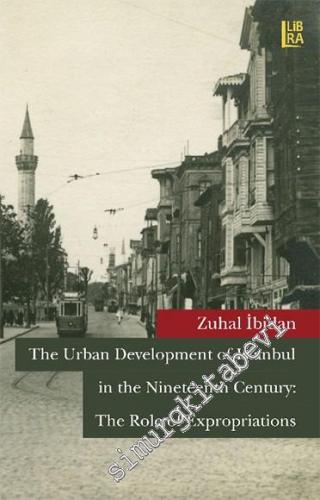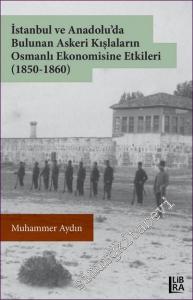#smrgKİTABEVİ The Urban Development of Istanbul in the Nineteenth Century: The Role of Expropriations -

While expropriations were carried out, it was emphasized that, especially when for “public interest”, the operation would be made with the consent of the landowner and after the preparation of maps. All of these can be said to be the reflections of modernity. This book examines the expropriation activities which were the most important tools for the government in the process of reconstruction implemented in Istanbul in the nineteenth century. It argues that the urban development which is at the intersection of centralization and modernization, and the concept of modern expropriation was a consequence of the change in the perspective and the understanding of the Ottoman government.
Additionally, in the book, while the concept of modern expropriation is being evaluated in relation to the transformation in the governmental and legal mentality, the economic and social aspects of the expropriations are also emphasized. Other reconstruction processes occurring in other cities in the Ottoman Empire and other European cities which were taken as models in the reconstruction process of the capital city were investigated and documented here for the sake of approaching the expropriations from a comparative angle. This book aims to offer a holistic addition to literature on the urban history of Istanbul in the nineteenth century.
İçindekiler
CHAPTER 1
INTRODUCTION
CHAPTER 2
THE LEGAL AND INSTITUTIONAL FRAMEWORK OF URBAN DEVELOPMENT IN ISTANBULIN THE NINETEENTH CENTURY
The Legal Framework of Urban Development in Istanbul in the Nineteenth Century The Administrative and Institutional Framework of Urban Development in Istanbul in the Nineteenth Century
CHAPTER 3
FIRES AND EXPROPRIATIONS
Three Big Fires in Istanbul in the Nineteenth Century and Their Role in Expropriations
The Aksaray Fire of 1855
The Hocapaşa Fire of 1865
The Beyoğlu Fire of 1870
CHAPTER 4
PUBLIC INTEREST AND EXPROPRIATIONS
Expropriations Applied Until the 1856 Expropriation Regulation
The First Major Expropriation For Public Interest: The Expropriation of Properties in Karaköykapısı in 1858
Expropriations for Tram Lines
Expropriations for the Construction of Tu¨nel
Expropriations for the Rumeli Railway Line
Other Expropriations
CHAPTER 5
DIFFERENT URBAN ACTORS AND THEIR RESPONSE TO EXPROPRIATIONS
The Problem of Value Estimation
The Role of Banks and Bankers
Assessment and Expropriation of Foreign Properties
Conflicts
CHAPTER 6
CONCLUSION
APPENDICES
BIBLIOGRAPHY
INDEX
While expropriations were carried out, it was emphasized that, especially when for “public interest”, the operation would be made with the consent of the landowner and after the preparation of maps. All of these can be said to be the reflections of modernity. This book examines the expropriation activities which were the most important tools for the government in the process of reconstruction implemented in Istanbul in the nineteenth century. It argues that the urban development which is at the intersection of centralization and modernization, and the concept of modern expropriation was a consequence of the change in the perspective and the understanding of the Ottoman government.
Additionally, in the book, while the concept of modern expropriation is being evaluated in relation to the transformation in the governmental and legal mentality, the economic and social aspects of the expropriations are also emphasized. Other reconstruction processes occurring in other cities in the Ottoman Empire and other European cities which were taken as models in the reconstruction process of the capital city were investigated and documented here for the sake of approaching the expropriations from a comparative angle. This book aims to offer a holistic addition to literature on the urban history of Istanbul in the nineteenth century.
İçindekiler
CHAPTER 1
INTRODUCTION
CHAPTER 2
THE LEGAL AND INSTITUTIONAL FRAMEWORK OF URBAN DEVELOPMENT IN ISTANBULIN THE NINETEENTH CENTURY
The Legal Framework of Urban Development in Istanbul in the Nineteenth Century The Administrative and Institutional Framework of Urban Development in Istanbul in the Nineteenth Century
CHAPTER 3
FIRES AND EXPROPRIATIONS
Three Big Fires in Istanbul in the Nineteenth Century and Their Role in Expropriations
The Aksaray Fire of 1855
The Hocapaşa Fire of 1865
The Beyoğlu Fire of 1870
CHAPTER 4
PUBLIC INTEREST AND EXPROPRIATIONS
Expropriations Applied Until the 1856 Expropriation Regulation
The First Major Expropriation For Public Interest: The Expropriation of Properties in Karaköykapısı in 1858
Expropriations for Tram Lines
Expropriations for the Construction of Tu¨nel
Expropriations for the Rumeli Railway Line
Other Expropriations
CHAPTER 5
DIFFERENT URBAN ACTORS AND THEIR RESPONSE TO EXPROPRIATIONS
The Problem of Value Estimation
The Role of Banks and Bankers
Assessment and Expropriation of Foreign Properties
Conflicts
CHAPTER 6
CONCLUSION
APPENDICES
BIBLIOGRAPHY
INDEX




















